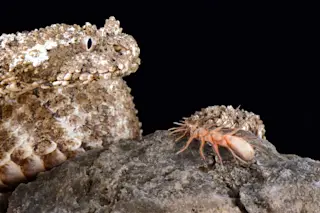When Steven Anderson first examined a specimen of the Iranian spider-tailed viper, he, of course, noticed the arachnid-shaped lump on the dead snake’s tail. It was 1970, and the herpetologist was at the Field Museum in Chicago examining what the museum assumed to be a Persian horned viper, a snake common throughout the Middle East.
But this one had such a bizarre growth on its tail. To Anderson, a biologist who studies reptiles in Southeast Asia, it resembled “an oval knob-like structure,” with long scales resembling appendages or legs. But with only a single specimen, it was impossible to say if this tail modification was due to genes or something else, like a parasite or cancerous growth. For nearly four decades, the snake lurked in the back of Anderson’s mind.
“All of a sudden, a few years ago this Iranian amateur naturalist Hamid Bostanchi found another one,” says Anderson, now ...














